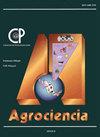PROXIMAL, THERMAL, AND STRUCTURAL CHARACTERIZATION OF STARCH EXTRACTED FROM TWO VARIETIES OF WHITE SORGHUM CULTIVATED IN MEXICO
IF 0.5
4区 农林科学
Q4 AGRICULTURE, MULTIDISCIPLINARY
引用次数: 0
Abstract
Sorghum (Sorghum bicolor) is a starch source that may contain tannins in red varieties, so white grains are preferred as a better alternative. The hypothesis of this study was that white sorghum starch grown in Mexico has the necessary properties for industrial use. The objective was to evaluate the chemical, thermal and structural characteristics of starch extracted from white sorghum var. Mazatlan-16, and RB-Paloma. Protein, moisture, ash, fiber, fat, water absorption rate, and swelling capacity were evaluated. Thermal properties were determined by calorimetry and viscosity analysis; structural properties by Fourier transform infrared spectroscopy and X-ray diffraction. One-way analysis of variance and Student’s t-test (p ≤ 0.05) were performed. The starch extracted from Mazatlán-16 grain contained the highest moisture (5.47 %), protein (0.72 %) and crude fiber values, and no significant differences (p ≤ 0.05) were found for ash and fat content in both starch varieties. The water absorption rate and swelling power was higher for RB-Paloma variety starch (p ≤ 0.05). Regarding thermal properties, the maximum viscosity temperature was 80.55 and 89 °C for RB-Paloma and Mazatlan-16 starch, respectively; the peak gelatinization temperature was higher for Mazatlan-16 (72.28 °C) and showed differences (p ≤0.05) with RB-Paloma. Structural analysis revealed that the starches of both varieties correspond to the A-type crystalline pattern, with the presence of OH, CH in stretching, H2O and CH2 groups. The starches extracted from the two varieties showed properties suitable for use as a viable alternative in the food industry.从墨西哥栽培的两种白高粱中提取的淀粉的近端、热和结构特征
高粱(高粱双色)是一种淀粉来源,在红色品种中可能含有单宁,因此首选白色谷物作为更好的选择。本研究的假设是,在墨西哥种植的白高粱淀粉具有工业用途所必需的特性。目的是评价白高粱品种mazatlanta -16和RB-Paloma中提取的淀粉的化学、热和结构特性。测定蛋白质、水分、灰分、纤维、脂肪、吸水率和膨胀能力。热性能通过量热法和粘度分析法测定;结构性质的傅里叶变换红外光谱和x射线衍射。进行单因素方差分析和学生t检验(p≤0.05)。Mazatlán-16籽粒淀粉的水分、蛋白质和粗纤维含量最高(5.47%),灰分和脂肪含量差异不显著(p≤0.05)。RB-Paloma品种淀粉的吸水率和溶胀力较高(p≤0.05)。热性能方面,RB-Paloma淀粉和mazatlantis -16淀粉的最大黏度温度分别为80.55℃和89℃;mazatlantis -16胶凝峰温度较高(72.28℃),与RB-Paloma胶凝峰温度差异显著(p≤0.05)。结构分析表明,这两个品种的淀粉都符合a型结晶模式,在拉伸、H2O和CH2基团中存在OH、CH。从这两个品种中提取的淀粉显示出适合作为食品工业可行替代品使用的特性。
本文章由计算机程序翻译,如有差异,请以英文原文为准。
求助全文
约1分钟内获得全文
求助全文
来源期刊

Agrociencia
农林科学-农业综合
CiteScore
0.50
自引率
33.30%
发文量
51
审稿时长
18-36 weeks
期刊介绍:
AGROCIENCIA is a scientific journal created and sponsored by the Colegio de Postgraduados. Its main objective is the publication and diffusion of agricultural, animal and forestry sciences research results from mexican and foreign scientists. All contributions are peer reviewed. Starting in the year 2000, AGROCIENCIA became a bimonthly and fully bilingual journal (Spanish and English versions in the same issue). Since 2007 appears every month and a half (eight issues per year). In addition to the printed issues, the full content is available in electronic format.
 求助内容:
求助内容: 应助结果提醒方式:
应助结果提醒方式:


